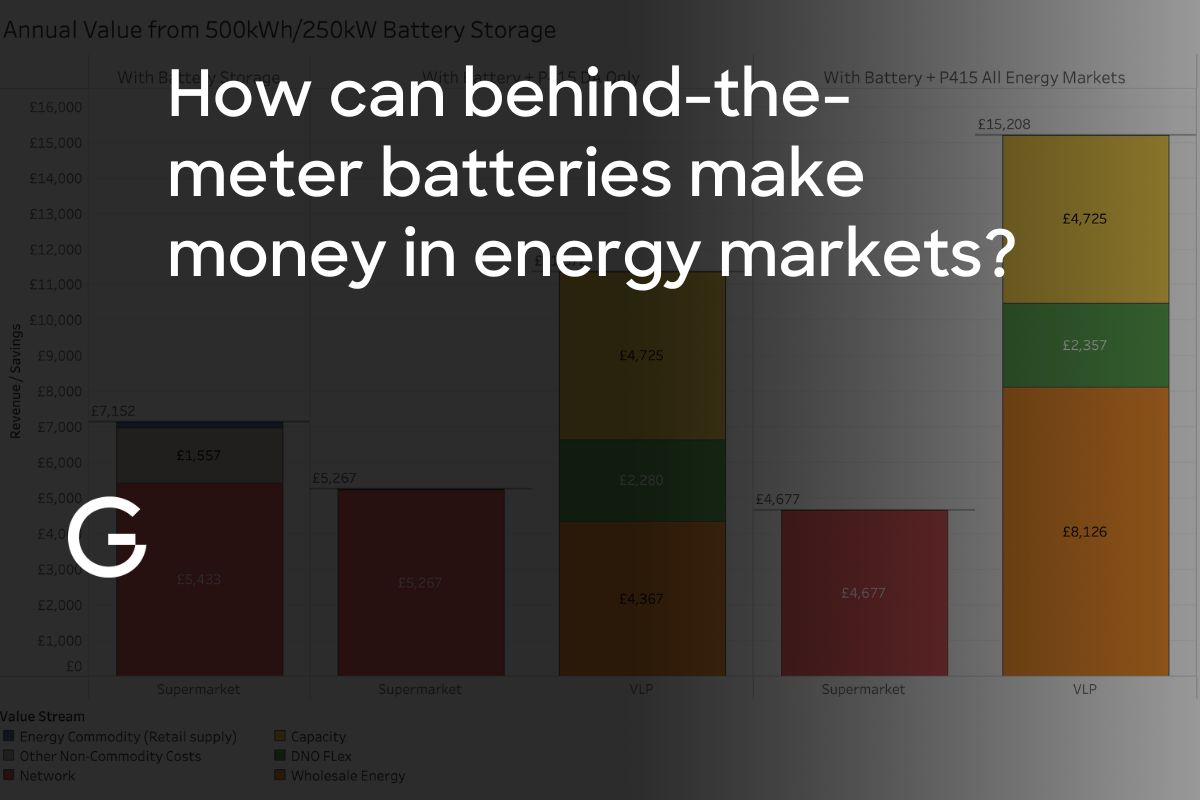Your world of energy.
Articles for energy natives, industry professionals and leaders.


Introducing Gridcog's new Operations Coordinator in London, Kate Orsborn

In this two-part post we’re looking at the commercial rationale for installing battery storage at a business premises.

Discover the top behind-the-meter (BTM) trends from Gridcog Unplugged London, including market reform, co-location strategies, and battery storage investments. Learn how regulatory changes and energy innovations are shaping the UK market in 2025.

With reducing capex costs and changing market dynamics the sweet spot for BESS duration in Australia's NEM is on the increase.

The UK’s grid connection system is getting a major shake-up. With NESO’s new 5MW Transmission Impact Assessment threshold and the shift to a 'first-ready, first-needed' approach, renewable energy projects will face a faster, more strategic approval process. What does this mean for energy investments, behind-the-meter assets, and future grid planning? We break it down in this blog.

In this two-part post we’re looking at the commercial rationale for installing battery storage at a business premises.

Explore the dynamics of price volatility and renewable generation records in GB and Australia. Learn how understanding market trends can unlock investment opportunities and support grid balancing.

Discover how integrating a Battery Energy Storage System (BESS) with solar can boost energy exports by 20% and revenues by 170%, even with reduced grid capacity. Learn how smarter storage optimises project economics in a grid-constrained world.

Introducing Gridcog's new Energy Analyst in London, Sebastien Behaghel!
.png)
Demystifying megawatts (MW) and megawatt-hours (MWh): this guide explains key energy concepts, capacity factors, storage durations, and efficiency differences across power technologies.

Often there’s an operational preference for charging EV fleets to full as soon as they return to the depot at the end of a shift. This post explores whether that approach is it the best way to do it.

Understanding Energy Storage Duration: BESS vs. Pumped Hydro and Market Impacts

Discover how capacity and energy-only markets shape energy investments, and how tools like Australia’s Capacity Investment Scheme support the transition to renewable energy while ensuring grid stability.

Explore the transformation of GB's energy landscape with over 19,000 embedded generators and 210GW of capacity in 2024, and learn how innovative solutions like Gridcog optimize investments amidst the challenges of balancing distributed renewable energy and grid stability.

Introducing Gridcog's new Energy Analyst in Melbourne, Catalina Villaro!

Increasing solar penetration causes TMY models to overestimate revenues, as they ignore correlations between high output and negative wholesale prices.

Introducing Gridcog's new Snr Business Development Manager, Evelyn Sleiman!

Explore 2024 European electricity market trends, from regional price differences and volatility to solar and storage investment opportunities.

Learn how ancillary services keep Europe’s grid stable during the renewable energy transition, with innovations like Battery Energy Storage Systems (BESS).

We explore how distribution networks can adapt to support renewable energy growth through flexible connections, local flexibility, and innovative tariffs.

We explore how distribution networks can adapt to support renewable energy growth through flexible connections, local flexibility, and innovative tariffs.

Introducing Gridcog's new Junior Commercial Associate, Kirsten Steen!

Introducing Gridcog's new marketing magician, Dan Pearson, as our Brand and Content Associate.

Explore how sustained negative energy prices in Australia's National Electricity Market have pushed the cumulative price into unprecedented territory, raising questions about market design and the lack of a defined price floor.

Learn how California’s new Limited Generation Profiles and more flexible interconnection options generally are helping to accelerate clean energy investment.

Exploring which European market offers the best return for investment into behind-the-meter solar and storage.

Co-incident peak demand charges cover the cost of grid capacity during rare high-demand periods. The blog reviews global examples, showing how these charges encourage reduced energy use and support the clean energy transition.

Explore how optimising battery storage systems in grid-connected energy projects can maximise financial and operational outcomes by aligning with network tariffs.

National Grid ESO's 2024 Future Energy Scenarios are out, spotlighting pathways to a net-zero Britain. Gridcog delves into the insights and what they mean for the future of renewable energy and grid innovation.

Discover how Piclo’s partnership with Victorian DNSPs brings flexible energy contracts to Australia. Learn about pricing, participation, and the potential impact on network operators and energy users.

Taking a deeper dive into Germany's ambitious solar PV deployment goals and the financial analysis of modelling different commercial options.

The Gridcog team is continuing to grow and we're excited to welcome our new Head of Finance, Dan Gevaux

Take a look at the different wholesale energy markets that make up the GB electricity market.

A detailed look into some of the common and different features of wholesale energy markets around the world.

Delve into the financial considerations of adding a battery to an existing solar Power Purchase Agreement (PPA)



